Vishnu Dreaming the Universe Art Sculpture Who Made It
- Introduction
- Epitome gallery
- In Hinduism
- Vaishnavism
- Natyashastra
- Shaktism
- Pancaratra
- Shilpashastra
- Purana
- Kavya
- Jyotisha
- Full general definition
- In Buddhism
- Mahayana
- Tibetan Buddhism
- In Jainism
- General definition
- India history
- Languages
- Marāthi
- Sanskrit
- Hindi
- Kannada
- Encounter also
Introduction:
Vishnu means something in Buddhism, Pali, Hinduism, Sanskrit, Jainism, Prakrit, the history of ancient India, Marathi, Hindi. If you want to know the exact meaning, history, etymology or English language translation of this term then check out the descriptions on this page. Add your comment or reference to a book if you desire to contribute to this summary article.
The Sanskrit term Viṣṇu tin can be transliterated into English language as Visnu or Vishnu, using the IAST transliteration scheme (?).
(+74 more images available)
Vaishnavism (Vaishava dharma)
Source: humindian: 108 names of Lord Krishna
One of the 108 names of Krishna; Meaning: "All Prevailing Lord"
Source: Shodhganga: The significance of the mūla-beras (vaishnavism)
Viṣṇu (विष्णु) has many manifestations namely Varadarāja Perumāl, Govindarāja Perumāl, Vaṭabhadra Śayana Perumāl, Kallalakar (Kallaḷakar), Śrīnivāsa, and many others; and the x incarnations, namely Matsya, Kūrma, Varāha, Narasiṃha, Vāmana, Paraśurāma, Raghurāma, Balarāma, Śrī Kṛṣṇa, and Kalki. The form of Viṣṇu is found in different ways. While viewing the sthānakmūrti of Viṣṇu, the perceiver experiences the karuṇā or mercy of the Lord. The face up is so pleasant that i feels to sit at the feet of the Lord and just wait into his optics. The reclining posture of Viṣṇu too attracts the perceiver.
When a devotee prays to Viṣṇu, he/she experiences the mercy or grace of the Lord. The devotee recollects the stories where the lord has blessed his devotees. One such striking example is the gajendra-mokṣa (the rescue of the elephant). The devotee thinks that when the lord was so chivalrous to an creature, then how much loving and caring will the lord be to his devotees who trust in Him. This great quality of God's love for the devotees is a re-assuring gene for the devotee.
Source: Pure Bhakti: Bhagavad-gita (4th edition)
Viṣṇu (विष्णु) refers to "literally, viś–'pervading', nu–'person'. One who is all-pervasive, the Supreme Lord of the cosmos who presides over the mode of goodness". (cf. Glossary page from Śrīmad-Bhagavad-Gītā).
Source: Pure Bhakti: Brhad Bhagavatamrtam
Viṣṇu (विष्णु) refers to:—The Supreme Personality of Godhead; ane who is all-pervading; the Supreme Lord of the creation who presides over the cloth style of goodness. (cf. Glossary page from Śrī Bṛhad-bhāgavatāmṛta).
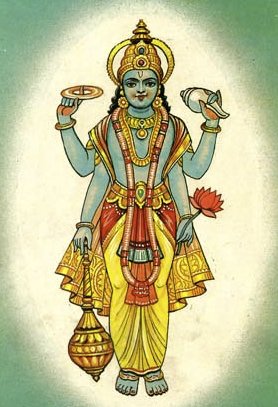
Vaishnava (वैष्णव, vaiṣṇava) or vaishnavism (vaiṣṇavism) represents a tradition of Hinduism worshipping Vishnu as the supreme Lord. Similar to the Shaktism and Shaivism traditions, Vaishnavism besides adult equally an individual movement, famous for its exposition of the dashavatara ('ten avatars of Vishnu').
Natyashastra (theatrics and dramaturgy)
Source: Wisdom Library: Nāṭya-śāstra
1) Viṣṇu (विष्णु) is a Sanskrit give-and-take referring to a deity. Acording to the Nāṭyaśāstra i.88-93, when Brahmā, Indra and all other gods went to inspect the playhouse (nāṭyamaṇḍapa) designed by Viśvakarmā, he assigned different deities for the protection of the playhouse itself, too as for the objects relating to dramatic performance (prayoga).
As such, Brahmā assigned Viṣṇu to the 3rd section (articulation/knot, parva) of the Jarjara (Indra's banner staf). The protection of the playhouse was enacted because of the jealous Vighnas (malevolent spirits), who began to create terror for the actors.
2) Viṣṇu is also to be worshipped during raṅgapūjā, according to the Nāṭyaśāstra 3.1-8. Accordingly, the primary of the dramatic art who has been initiated for the purpose shall consecrate the playhouse later he has made obeisance (due east.g., to Viṣṇu).
Source: archive.org: The mirror of gesture (abhinaya-darpana)
One of the hands that indicate the forms which accordance with the grapheme and deportment of Brahmā and other Devas.—Viṣṇu: Tripatāka with both hands.
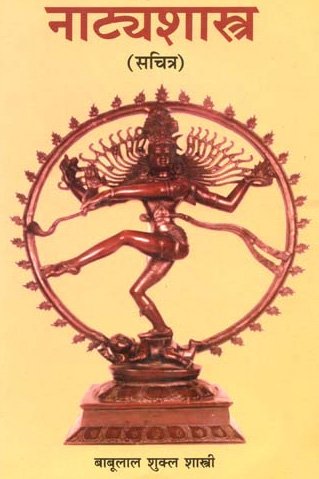
Natyashastra (नाट्यशास्त्र, nāṭyaśāstra) refers to both the ancient Indian tradition (śāstra) of performing arts, (nāṭya, e.m., theatrics, drama, dance, music), as well as the proper noun of a Sanskrit work dealing with these subjects. It too teaches the rules for composing dramatic plays (nataka) and poetic works (kavya).
Shaktism (Shakta philosophy)
Source: Wisdom Library: Śāktism
Viṣṇu (विष्णु):—One of the male offspring from Mahāsarasvatī (sattva-form of Mahādevī). Also known every bit Kṛṣṇa, Hṛṣīkeśa, Vāsudeva and Janārdana. Mahāsarasvatī is one of the three primary forms of Devī, the other ii beingness Mahālakṣmī and Mahākālī. Not to exist confused with Sarasvatī, she is a more than powerful catholic aspect (vyaṣṭi) of Devi and represents the guṇa (universal energy) named sattva. Also run across the Devī Māhātmya, a Sanskrit work from the 5th century, incorporated into the Mārkaṇḍeya-Purāṇa.
Source: Google Books: Manthanabhairavatantram
1) Viṣṇu (विष्णु) refers to "the pervasive one", according to the second recension of the Yogakhaṇḍa of the Manthānabhairavatantra, a vast sprawling work that belongs to a corpus of Tantric texts concerned with the worship of the goddess Kubjikā.—Accordingly, as Kumārī said: "[...] I am the Vaiṣṇavī and the power that is the crusade of the universe's persistence. (I am) Vaiṣṇavī, the five-fold energy; (I am) Viṣṇu'south essential nature (ātman) and the deity. [...] Everything is the universe made of Viṣṇu. The seed is said to be Brahmā. Viṣṇu is persistence. Viṣṇu is the ocean. Viṣṇu is the Pervasive 1 (viṣṇu) who is the supreme divine form. He holds a conch, discus and mace. Know that Rudra is made of Viṣṇu and Viṣṇu is subtle, supreme (transcendent) and inferior (immanent). Viṣṇu is universal pervasion. He is the intellect, heed and ego. [...]".
2) Viṣṇu (विष्णु) or Viṣṇugranthi refers to the "Knot of Viṣṇu" and represents ane of the "xvi knots" (granthi), according to the Ṣaṭsāhasrasaṃhitā, an expansion of the Kubjikāmatatantra: the primeval popular and most administrative Tantra of the Kubjikā cult.—Accordingly, "(1) The Knot called Ananta, which is HAṂSA, should be placed (on the torso). Information technology is at the middle toe of the sixteen parts (of the body).The Knot of Time is beneath the ankle. [...] (12) The Knot of the Living Being is in the identify of the heart, while (thirteen) the one chosen Viṣṇu [i.e., viṣṇu-granthi] is in the throat. [...]".
The 16 Knots [i.e., viṣṇu-granthi] are parts of the goddess'south torso. Accordingly, they are projected into the skillful'south body to transform it into the Triple Fort, that is, the triangular torso of the goddess replete with the energies of the sacred seats. She is both with form, consisting of the letters and mantras, and without form equally the Transmental (manonmanī) energy of the god.
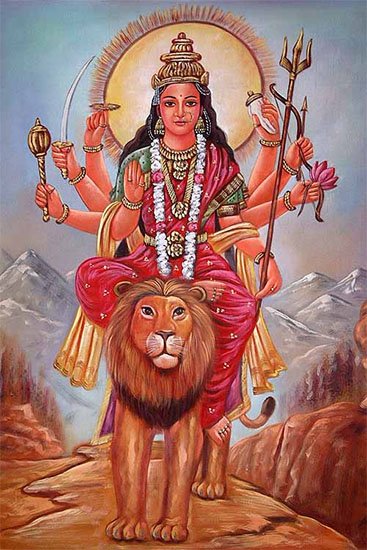
Shakta (शाक्त, śākta) or Shaktism (śāktism) represents a tradition of Hinduism where the Goddess (Devi) is revered and worshipped. Shakta literature includes a range of scriptures, including various Agamas and Tantras, although its roots may be traced back to the Vedas.
Pancaratra (worship of Nārāyaṇa)
Source: Wisdom Library: Pāñcarātra
1) Viṣṇu (विष्णु, "all-pervading"):—Ane of the twenty-four forms of Viṣṇu through which Nārāyaṇa manifests himself. He is accompanied by a analogue emanation of Lakṣmī (an attribute of Devī) who goes by the name Dhṛti.
ii) Viṣṇu (विष्णु) refers to an aspect of nṛsiṃha ('man-lion'), co-ordinate to the Vihagendra-saṃhitā iv.17, which mentions lxx-four forms (inlcuding 20 forms of vyūha). He is also known equally Viṣṇunṛsiṃha or Viṣṇunarasiṃha. Nṛsiṃha is a Tantric deity and refers to the furious (ugra) incarnation of Viṣṇu.
The 15th-century Vihagendra-saṃhīta is a canonical text of the Pāñcarātra corpus and, in twenty-4 chapters, deals primarely with meditation on mantras and sacrificial oblations.
Source: Shodhganga: Iconographical representations of Śiva (pancaratra)
Viṣṇu (विष्णु) or Viṣṇusaṃhitā is the name of a Vaiṣṇava Āgama scripture, classified equally a sāttvika type of the Muniprokta grouping of Pāñcarātra Āgamas. The vaiṣṇavāgamas represent ane of the three classes of āgamas (traditionally communicated wisdom).—Texts of the Pāñcara Āgamas are divided in to 2 sects. Information technology is believed that Lord Vāsudeva revealed the first grouping of texts which are chosen Divya and the next grouping is chosen Muniprokta which are farther divided in to three viz. a. Sāttvika (e.g., Viṣṇu-saṃhitā). b. Rājasa. c. Tāmasa.
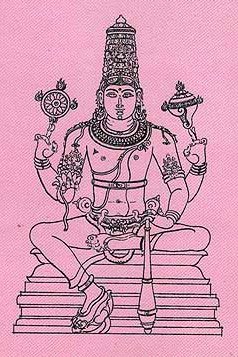
Pancaratra (पाञ्चरात्र, pāñcarātra) represents a tradition of Hinduism where Narayana is revered and worshipped. Closeley related to Vaishnavism, the Pancaratra literature includes various Agamas and tantras incorporating many Vaishnava philosophies.
Shilpashastra (iconography)
Source: Wisdom Library: Śilpa-śāstra
Viṣṇu (विष्णु) is a Sanskrit name referring to one of the 8 manifestations of Caṇḍa, who is a form of Bhairava. According to the Rudrayāmala, at that place are viii primary forms of Bhairava who control the 8 directions of this universe. Each form (e.thousand., Caṇḍa) has a further viii sub-manifestations (due east.m., Viṣṇu), thus resulting in a total of 64 Bhairavas.
When depicting Viṣṇu according to traditional iconographic rules (śilpaśāstra), one should depcit him (and other forms of Caṇḍa) having a blue color and good looks; he should carry agni, śakti, gadā and kuṇḍa. The word Śilpaśāstra refers to an ancient Hindu science of craft, dealing with subjects such as painting, sculpture and iconography.
Source: annal.org: Pratima Kosa Encyclopedia of Indian Iconography - Vol 6
Viṣṇu (विष्णु) refers to one of the many varieties of the Śālagrāma (ammonite fossil stones).—The Viṣṇu stone has the size and shape of a bilva fruit, blackness in colour, a pigsty at the back (pṛṣṭha-chidra). . Śālagrāma stones are very aboriginal geological specimens, rendered rounded and smooth past h2o-currents in a dandy length of time. They (e.yard., Viṣṇu stones) are distinguished by the ammonite (śālā, described as "vajra-kīṭa", "adamantine worms") which having entered into them for residence, are fossilized in form of fourth dimension, leaving discus-like marks inside the rock.
Source: archive.org: Nilamata Purana: a cultural and literary study (silpa)
Viṣṇu (विष्णु) is the proper noun of a deity once commonly worshipped in ancient Kashmir (Kaśmīra) as mentioned in the Nīlamatapurāṇa.—As regards the advent and the weapons of Viṣṇu, the Nīlamata describes him every bit four-armed, four-faced, lotus-eyed, having a complexion like that of a blue lotus or white snow, wearing white or yellow dress, a crown of jewels and also ear-rings. His weapons are conch, discus, club, lotus, sword and bow—the last one made of horn. He is waited upon past his weapons in human being form as well. He lies on the jewelled hood of Śeṣa with his lotus like anxiety placed in the lap of Lakṣmī. His mount is Garuḍa, the enemy of the Nāgas.
Source: Red Zambala: Hindu Icons and Symbols | Trinity
Viṣṇu is the name given to the cohesive or centripetal trend of the universe — the Sattva Guṇa. It pervades all existence and is therefore known as "Viṣṇu". The name tin be derived from the roots viṣ — viṣṇāti — to spread. viṣ — viṣati — to enter into or from viṣti — viveṣṭi — to surround = all these are expressions of pervasion.
In terms of consciousness Viṣṇu is identified with the dream-country (svapna) where things are conceived of as archetypes or prototypes prior to their manifestation. He is the abstruse concept of all things whereas Brahmā is their realization in perishable materials.
Viṣṇu is the inner cause, the unseen power past which all things be. Brahma is concerned with the outer material manifestation of all things, but Viṣṇu is their inner essence. Viṣṇu is the principle of elapsing and the ability that holds the creation together. He is therefore the goal of all spiritual and religious paths.
Source: Archaeological Survey of Bharat: Śaiva monuments at Paṭṭadakal (śilpa)
Viṣṇu (विष्णु) is a sculpture constitute at the temple of Vijayeśvara, at the northern side.—On the north side at that place are two niches and in both at that place are images of Viṣṇu with iv arms. The first one displays a continuing Viṣṇu with iv arms holding in his upper hands: right cakra, left conch, lower right resting on the thigh and the lower left belongings a round object which is identified as the globe by locals. He is decked with all usual ornaments. This paradigm is cute because the carving is completed. The next image depicts likewise Viṣṇu just information technology is incomplete. Only iii of his hands are seen with discus in the upper right and mace in the lower correct, the lower left resting on the thigh. The upper left is incomplete. He wears a tiara but the image is yet to be completed and polished.
A sculpture of Viṣṇu is also constitute on the sixth pillar of the southern half of the maṇḍapa.—In the top medallion is seated Viṣṇu on Garuḍa. He is shown with four easily, having usual conch and discus in his upper left and correct hands respectively. Of the lower two, the correct is some gesture of holding something and the left is resting on his thigh. Garuḍa is seated in vīrāsana. Past the side of Viṣṇu is a running river.
Source: What is India: Inscriptions of the Śilāhāras (shilpashastra)
Viṣṇu (विष्णु) every bit depicted according to an image found in the Jondhalī Baug on the Ṭhāṇā-Āgrā.—From the weapons held in its hands, the paradigm appears to exist of the Śrīdhara blazon. It measures 125 cm. in height and is continuing in the samabhaṅga pose. Viṣṇu holds the lotus, the discus, the mace and the conch in his easily and wears several necklaces and a torque. His yajñopavita and campakamālā are prominently seen. He has a high karaṇḍa-mukuṭa with a lotus prabhāvalī actualization behind it. He wears beautiful ear-ornaments, bracelets and anklets, and the folds of his lower garment are shown falling gracefully in forepart. He has a fine smile playing on his face. On the correct is shown the donor of the epitome in the añjalimudrā, and on the left his married woman with a pot full of sweets. Past their side are seen ii gaṇas holding musical instruments.
Source: Shodhganga: The significance of the mūla-beras (śilpa)
Viṣṇu is the name of a deity depicted in the Thillai Nataraja Temple in Cidambaram (Chidambaram) which is one of the Pañcasabhā or "5 halls where Śiva is said to have danced".— Unremarkably Viṣṇu is constitute in standing posture. Information technology is rare to find Viṣṇu in sitting posture. Just here he is found seated in sukhāsana/vīrāsana posture. He is institute with iv hands. The upper easily agree discus and conch in the right and the left in kartarīmukha-hasta. The lower right and the lower left hand are in abhaya and kaṭaka-hasta. The lower left paw holds a flower.
Viṣṇu is also depicted at Ramaswamy Temple in Kumbakonam (Kumbhakonam), representing a sacred identify for the worship of Viṣṇu.—Viṣṇu is found seated on an elephant in sukhāsana posture. He is establish with 2 hands. The right manus holds śakti and the left hand holds aṅkuśa. There is another sannidhi of Viṣṇu where he is establish in standing posture. Viṣṇu is found with 4 hands. The upper right mitt and the upper left hand concord cakra and sankhu respectively in kartarīmukha- hasta. The lower right and left hands are held in kaṭaka-hasta. In another sannidhi, Viṣṇu is establish in standing posture with two hands. The right hand is held in abhaya-hasta and the left hand is in urū-hasta.
Viṣṇu is also depicted in the Subramanya Swamy Temple (or Subramaṇya Svāmi Temple) in Thiruparankundram or Parankundram (Paraṅkuṉṟam), representing a sacred place for the worship of Murugan.—Viṣṇu is represented with conch and discus in the upper correct and left hands in kartarīmukha-hasta. The lower left hand is in kuvi- patāka (resting on the mace) and the lower right mitt is in patāka hasta inverted. He is represented as the sthānaka mūrti here. In iconographic terms, Viṣṇu is represented with kartarīmukha in the upper hands. The lower left hand is in nidrā-hasta and the lower right hand is in abhaya-hasta. To the left of the Andarabharanar sannidhi, there are steps that go to the right of the main sanctum. At that place are steps that lead to the Ṣ anmukhan sannidhi.
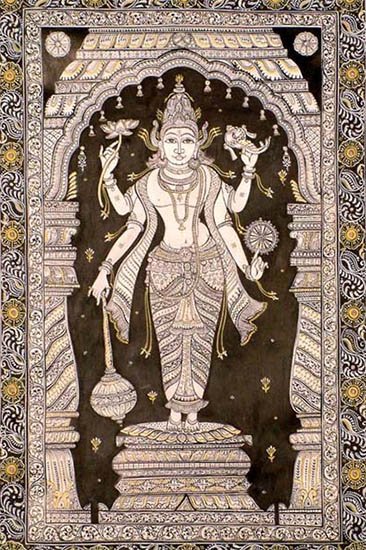
Shilpashastra (शिल्पशास्त्र, śilpaśāstra) represents the aboriginal Indian science (shastra) of creative arts (shilpa) such as sculpture, iconography and painting. Closely related to Vastushastra (compages), they ofttimes share the same literature.
Purana and Itihasa (epic history)
Source: annal.org: Puranic Encyclopedia
Viṣṇu (विष्णु).—General information. Brahmā, Viṣṇu and Maheśvara are the Lords of cosmos, sustenance and extermination of this perishable universe. These trimūrtis (three figures) as well are perishable. It is said, that one day of Brahmā will constitute chiliad four-fold (catur) yugas and that during the life of Brahmā, 14 Indras will fall down from heaven and die. This is a Brahmā historic period. The ages of 2 Brahmās constitute the historic period of i Viṣṇu. At the terminate of the age Viṣṇu as well will perish. The historic period of Śiva is double the age of Viṣṇu. Śiva also volition perish at the terminate of his age. (Devī Bhāgavata, Skandha five). (Meet full article at Story of Viṣṇu from the Puranic encyclopaedia by Vettam Mani)
Source: annal.org: Nilamata Purana: a cultural and literary written report
Viṣṇu (विष्णु) is the proper noun of a deity once normally worshipped in ancient Kashmir (Kaśmīra) as mentioned in the Nīlamatapurāṇa.—The Nīlamata, like other Vaiṣṇava Purāṇas, describes Viṣṇu every bit the highest god, praised and honoured even past Brahmā and Śiva. The ultimate cause of the universe, he pervades the whole universe and is ever busy in rescuing the devotees from distress, showing them the right path, giving them boons and destroying the Dānavas.
Source: archive.org: Shiva Purana - English Translation
Viṣṇu (विष्णु) is the name of deity equally explained in the Śivapurāṇa ii.one.6, while explaining how Śiva desired to create another beingness similar himself. Appropriately, every bit Śiva said:—"You lot volition be famous as Viṣṇu past name as you are all-pervasive. You will take many other names conferring happiness on devotees. Perform penance highly conducive to the achievement of the affair in manus, Be firm in information technology". Saying so, the lord bestowed on him the Vedas through his nostrils".
The description of Viṣṇu every bit he came into beingness is given as follows: "[...] a person came into being who was the most charming 1 in the three worlds (trailokya), who was calm with sattva-guṇa being prominent, and who appeared to be the ocean of immeasurable majesty. O sage, he was endowed with patience. There was no 1 comparable to him. He had the lustre of sapphire. He was glorious with his excellent eyes shining similar a lotus. He was having a gilt form and features. He wore two splendid silk garments of aureate color. His were browny and brilliant. He was indefatigable"
Source: Cologne Digital Sanskrit Dictionaries: The Purana Index
1a) Viṣṇu (विष्णु).—The name of the sun in the calendar month of Ūrja (Kārtika);1 an Āditya and Lord of Ādityas;2 in the sun's chariot in Phālguna.3
- one) Bhāgavata-purāṇa XII. 11. 44; Brahmāṇḍa-purāṇa Two. 23. 20; Vāyu-purāṇa 66. 61, 66.
- 2) Brahmāṇḍa-purāṇa II. 24. 34; Three. 3. 68; Matsya-purāṇa 6. iv; 171. 56. Viṣṇu-purāṇa I. 15. 130.
- 3) Ib. I. 22. 3; II. ten. xviii.
1b) A god of Ābhūtaraya group.*
- * Brahmāṇḍa-purāṇa Two. 36. 56.
1c) (Uttamaśloka) worshipped for dharma. His abode above the position of seven sages, where is found the peachy Dhruva with others;1 unlike forms of; equally Trivikrama bankrupt aṇḍakaṭāha and let the Ganges in; as Saṅkarṣaṇa, worshipped by Śiva in Ilāvṛta; as Hayagrīva in Bhadrāśva state; equally Nṛsimha in Harivarṣa; as Kāmadeva in Ketumālā; as Matsya in Ramyaka; as Kūrma in Hiraṇmaya; also Sānkhyanidarśana; as Varāha in Uttara Kuru country; also in the course of both Yajña and Kratu; equally Sītārāma in Kimpuruṣa; as Naranārāyaṇa in Bhāratavarṣa; equally Sūrya in Plakṣadvīpa; as Soma in Śālmali; equally Agni in Kuśadvīpa; equally a course of water in Krauñcadvīpa; as Vāyu in Śākadvīpa; as Brahmā in Puṣkaradvīpa.ii Propitiated past Dakṣa subsequently his reconciliation with Śiva, Viṣṇu came to receive offerings in person in the class of yajña and was praised by all present including Brahmā and Śiva. He told Dakṣa that he was non different from Śiva or Brahmā.3 presented Pṛthu with Sudarśana and addressed him to befriend Indra, to be devoted to Him and to conduct himself righteously.four His residence virtually Kṣīroda where he sleeps in yoga: vanquisher of Bali; saw a liṅga of effulgence and with Brahmā went down and upwards to know its origin and stop, but could non become at that. Śiva's remark that his correct and left artillery were Brahmā and Viṣṇu. This is Mahāyāgam and Māheśvaram balam;v cursed by Bhṛgu to take 10 (7 Matsya-purāṇa) incarnations on the earth; called Puruṣa and Yajña.6 In Svāyambhuva epoch was built-in of Ākūtī, in Svārociṣa, born of Tuṣitā every bit Ajita, in Uttama epoch, built-in of Satyā as Satya, in Tāmasa built-in of Hariṇī as Hari, in Vaivasvata, born of Kaśyapa and Aditī with the proper name Vaikuṇṭha.7 Overlord of Ādityas; gave peacock and fowl to Kumāra.eight
- 1) Bhāgavata-purāṇa II. 3. 22; III. ch. 13 (whole); V. 22. 17; 23. 1.
- 2) Ib. V. 17. 1 and 16; chh. eighteen-20 (whole);
- iii) Ib. IV. 7. 18-54; 14. 26.
- 4) Ib. Four. 15. 16; xx. 2-16, 31 [i-2].
- 5) Brahmāṇḍa-purāṇa Two. 26. 2; 27. 22.
- 6) Ib. 3. 3. 85-106; 72. 3-17; Matsya-purāṇa 47. 99-103.
- vii) Brahmāṇḍa-purāṇa III. 107-122.
- 8) Ib. III. 10. 46; 24. half-dozen; 33. 15; 42. 48; 71. 176 and 262. Matsya-purāṇa 6. iv; 171. 56.
1d) A Bhārgava gotrakāra.*
- * Matsya-purāṇa 195. twenty.
1e) One of the 9 sons of Sāvarṇi.*
- * Vāyu-purāṇa 100. 22.
Source: JatLand: List of Mahabharata people and places
Viṣṇu (विष्णु) is a name mentioned in the Mahābhārata (cf. I.33, I.29.three, I.59.16, I.65, VI.ix.21, Eight.thirty.78, IX.44.four, IX.44.33) and represents 1 of the many proper names used for people and places. Notation: The Mahābhārata (mentioning Viṣṇu) is a Sanskrit epic poem consisting of 100,000 ślokas (metrical verses) and is over 2000 years erstwhile.
Source: Shodhganga: The saurapurana - a critical study
one) Viṣṇu (विष्णु) is created by Śiva for the protection of the Universe, according to the 10th century Saurapurāṇa: ane of the various Upapurāṇas depicting Śaivism.—In the Saurapurāṇa he is a form of Śiva and constitutes Śiva's left side. He is created past Śiva for the protection of the Universe and he protects only by the club of Śiva. Viṣṇu's various incarnations are referred to. His worship is enjoined. A vrata known as Śrāvaṇadvādaśī in award of Viṣṇu is described in the Saurapurāṇa (xv.2ff).
two) Viṣṇu (विष्णु) is the name of i of the twelve Ādityas: the offspring of Aditi, according to ane account of Vaṃśa ('genealogical description') of the Saurapurāṇa.—Accordingly, Dakṣa gave thirteen daughters to Kaśyapa. [...] Kaśyapa's 13 wives are [viz., Aditi]. Aditi gives birth to twelve Ādityas, [viz. Viṣṇu].
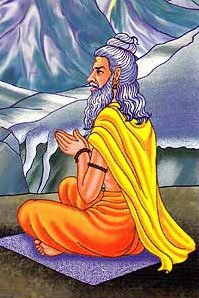
The Purana (पुराण, purāṇas) refers to Sanskrit literature preserving aboriginal Bharat's vast cultural history, including historical legends, religious ceremonies, various arts and sciences. The eighteen mahapuranas total over 400,000 shlokas (metrical couplets) and date to at to the lowest degree several centuries BCE.
Kavya (poetry)
Source: Shodhganga: A critical appreciation of soddhalas udayasundarikatha
Viṣṇu (विष्णु).—Viṣṇu, a deity of Ṛgveda is reborn in Puranic Pantheon and has caused a new glory and boundless ability. New epithets are given to him as for example, Hari, Trivikrama, Muraripu, Murāri, Caturbhuja, Upendra, Cakrapāṇi, Nanārdana, Kaṃsāri, Murajit, Acyuta, Śārṅgin, Kaiṭabhāri, Madhuripu and Asuradviṣ.
Viṣṇu in Ṛgveda is a sun deity, who similar the sun takes three strides (vikrama) beyond the 3 kinds of infinite. In that location his weapon as a precursor of the after Cakra is a revolving bicycle represented like the dominicus. The inferior position of Viṣṇu equally a sun-deity in Ṛgveda is changed to one of supreme importance in the Brāhmaṇas, where he already assumes the course of a dwarf and rescues the earth from the Asuras in three strides.
Viṣṇu reclines on the couch formed hy Śeṣa, the one thousand-hooded serpent. He is referred to every bit resting on the lap of Lakṣmī and waring on his breast a jewel named Kaustubh and he is waited upon by the humble Garuḍa.
Kavya (काव्य, kavya) refers to Sanskrit poetry, a popular aboriginal Indian tradition of literature. At that place have been many Sanskrit poets over the ages, hailing from ancient Republic of india and beyond. This topic includes mahakavya, or 'epic poetry' and natya, or 'dramatic poesy'.
Jyotisha (astronomy and star divination)
Source: Wisdom Library: Brihat Samhita by Varahamihira
Viṣṇu (विष्णु) refers to ane of the twelve yugas of Jupiter's wheel, co-ordinate to the Bṛhatsaṃhitā (chapter 8), an encyclopedic Sanskrit work written by Varāhamihira mainly focusing on the science of ancient Indian astronomy astronomy (Jyotiṣa).—Accordingly, "The twelve yugas of Jupiter'south bike are known every bit belonging to the Devas one. Viṣṇu, 2. Jupiter, 3. Indra, 4. Agni (burn down), 5. Tvaṣṭā, 6. Ahirbudhnya, 7. The Pitṛs, 8. Vāsudeva, nine. Soma (the Moon), 10. Indrāgni, xi. Aśvinideva, 12. Bhaga (the Sun)".
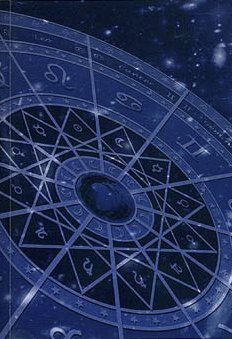
Jyotisha (ज्योतिष, jyotiṣa or jyotish) refers to 'astronomy' or "Vedic astrology" and represents the fifth of the six Vedangas (additional sciences to be studied along with the Vedas). Jyotisha concerns itself with the written report and prediction of the movements of celestial bodies, in order to calculate the auspicious time for rituals and ceremonies.
General definition (in Hinduism)
Source: Apam Napat: Indian Mythology
Vishnu is the protective attribute of the supreme trinity. He is the entity that is most often involved in mortal affairs. Some say he was created by Shiva, others say that he arose out of the catholic void. Laxmi is his consort. His abode is Vaikunta. He is usually depicted as resting on a giant snake, Adisesha, which is itself floating in an ocean of milk.
He has undertaken x avatars(incarnations), each to achieve a specific purpose, to avert a specific calamity facing either mankind or the Devas. In that location are more than than 10 incarnations attributed to him, but only ten of them are considered major. The list of such avatars varies a bit in different sources. For more about his incarnations, run into 'Incarnations of Vishnu'.
He is chosen the 'brother of Indra', since he was born as a son of Aditi in his Vamana avatar. He is described as being ever desirous of helping the Devas, and an enemy of their half-brothers, the Asuras. He is dark-colored, with mega-varnam (cloud-hued), being one of his epithets. He is by and large depicted as having four artillery, holding a Sudharshana Chakra (discus), conch, lotus and a mace respectively.
His consort is Laxmi, who is said to accept arisen from the ocean of milk in Vaikunta, when it was churned by the Devas and Asuras to obtain Amrit. His followers are known as Vaishnavaite, and many of them wearable the 'namam' on their brow.
Source: Shodhganga: The saurapurana - a critical study (h)
Viṣṇu (विष्णु) in the Ṛgveda occupies a subordinate position and his but anthropomorphic traits are the 3 strides, which, as a solar god, he takes across the heavens. He traverses the three worlds in 3 strides referring probably to the Dominicus in the heavens through the three stages of arising, culminating and setting or the three steps with which he encompasses the Universe. This trait of Vedic Viṣṇu was afterward symbolized in his incarnation as Vāmana who asked country from Bali to be covered in three strides.
In the Brāhmaṇas, the position of Viṣṇu remains much the same; he is regarded as equal to other gods and not their superior. In the older portion of the Mahābhārata, Viṣṇu is little more than than a hero, in others he is represented equally paying homage to Śiva. In the latest portion of the not bad epic, he is regarded every bit the most exalted deity. In the Rāmāyaṇa and the Vaiṣṇava Purāṇas he is exalted to exist the supreme Deity.
Mahayana (major branch of Buddhism)
Source: Wisdom Library: Maha Prajnaparamita Sastra
1) Viṣṇu (विष्णु) is the name of a deity mentioned in the 2nd century Mahāprajñāpāramitāśāstra (affiliate IV). Other individuals likewise know all the dharmas, e.g., Wei nieou (Viṣṇu) [in the language of Ts'in, Pien wen, 'Univeral Eye']: he has iv arms (caturbhuja), holds a conch (śaṅka) and a wheel (cakra), and rides a golden-winged bird (garuda). All these gods are smashing guides (mahānāyaka). They cannot be omniscient. Why? Because their mind remains fastened (abhiniviṣṭa) to hatred (dveṣa) and pride (abhhimāna).
2) Viṣṇu (विष्णु) refers to the deity that appears on the great waters (maha-apas) after the kalpa-burn down according to the 2nd century Mahāprajñāpāramitāśāstra (chapter XIV).—Afterwards the kalpa-fire, everything is empty (śūnya); then by the causal power of the merits of beings, the winds (vāyu) come from all the directions and, interacting and mixing with one another, they are able to support the cracking waters (mahāpas). On these waters at that place is a human being with a one thousand heads, two thousand arms and two thousand legs called Wei mieou (Viṣṇu).
From Viṣṇu's navel (nābhi) comes a precious lotus, golden in color, with a thou petals, the calorie-free and rays of which are like the combined light of a k suns. On this lotus in that location is seated cross-legged a man who, in turn, possesses an infinite light. He is called Fan t'ien wang (Brahmādevarāja) who mentally gives birth to viii sons who, in their turn, give rise to the heavens, the globe and people.
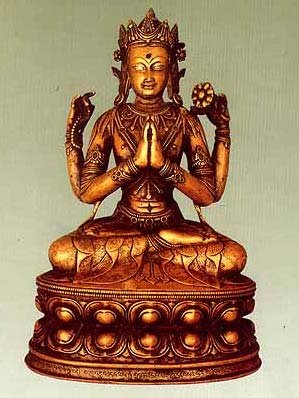
Mahayana (महायान, mahāyāna) is a major branch of Buddhism focusing on the path of a Bodhisattva (spiritual aspirants/ aware beings). Extant literature is vast and primarely composed in the Sanskrit language. There are many sūtras of which some of the earliest are the various Prajñāpāramitā sūtras.
Tibetan Buddhism (Vajrayana or tantric Buddhism)
Source: annal.org: The Indian Buddhist Iconography
Viṣṇu (विष्णु) is the name of a deity commonly depicted in Buddhist Iconography, and mentioned in the 11th-century Niṣpannayogāvalī of Mahāpaṇḍita Abhayākara.—His Vehicle is the Garuḍa; he has four artillery.
Viṣṇu is described in the Niṣpannayogāvalī (dharmadhātuvāgīśvara-maṇḍala) equally follows:—
"On a Garuḍa there is Viṣṇu with four arms. With the 2 chief hands carrying the cakra and the śaṅkha he displays the añjali on his head. With the two others he holds the gadā (mace) and the bow".
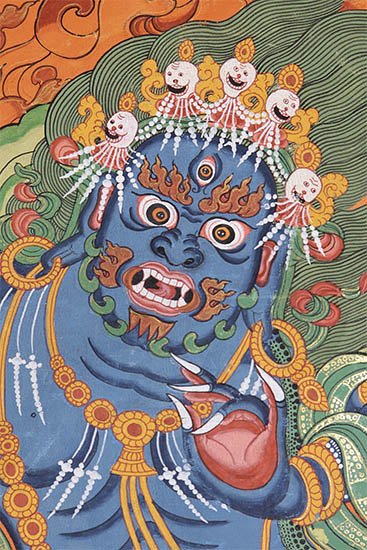
Tibetan Buddhism includes schools such as Nyingma, Kadampa, Kagyu and Gelug. Their principal canon of literature is divided in two broad categories: The Kangyur, which consists of Buddha's words, and the Tengyur, which includes commentaries from various sources. Esotericism and tantra techniques (vajrayāna) are collected indepently.
General definition (in Jainism)
Source: Wisdom Library: Jainism
Viṣṇu (विष्णु) is the father of Śreyāṃsa, the eleventh of twenty-four Tīrthaṅkaras in Janism according to the Ācāradinakara (14th century work on Jain bear written by Vardhamāna Sūri). A Tīrthaṅkara is an enlightened being who has conquered saṃsāra (cycle of birth and decease), leaving backside him a path for others to follow.
The married woman of Viṣṇu is Viṣṇu according to Śvetāmbara or Veṇudevī according to Digambara. It is an ancient Jain practice to worship the Tīrthaṅkara's parents in diverse rites, such as the pratiṣṭhāvidhi.
Source: archive.org: The Jaina Iconography
Viṣṇu (विष्णु) or Viṣṇudeva is the father of Śreyāṃśanātha: the eleventh of xx-four Tīrthaṃkaras or Jinas, commonly depicted in Jaina iconography.—The Jaina Purāṇas record his lineage. His father was a Kṣatriya prince of Ikṣvāku clan named Viṣṇu (Viṣṇudeva) and his mother was called Viṣṇudri. His home was at Siṃhapurī, the present Sārnāth.
Source: archive.org: Trisastisalakapurusacaritra
1) Viṣṇu (विष्णु) refers to a sub-division of the Kulārya grade of Āryas (one of the two types of human beings), taking nascency in the "middle world" (madhyaloka), according to affiliate 2.3 [ajitanātha-caritra] of Hemacandra's 11th century Triṣaṣṭiśalākāpuruṣacaritra ("lives of the 63 illustrious persons"): a Sanskrit epic poem narrating the history and legends of threescore-three of import persons in Jainism.—(cf. Commentary to Tattvārthādhigamasūtra 3.xv)
Appropriately:—"In these 35 zones on this side of Mānuṣottara and in the Antaradvīpas, men arise past birth; [...]. From the partitioning into Āryas and Mlecchas they are two-fold. The Āryas accept sub-divisions: kṣetra (state), jāti (caste), kula (family), karma (work), śilpa (craft), and bhāṣā (language). [...] Kulāryas are the Kulakaras, Cakrins, Viṣṇus, and Balas, or those who are built-in in a pure family from the tertiary, fifth, or seventh generation".
two) Viṣṇu (विष्णु) is the married woman of rex Viṣṇurāja and mother of Śreyāṃsa, according to affiliate iv.1 [śreyāṃsanātha-caritra].—Accordingly, "Viṣṇurāja, rich in glory, powerful from strength of arm, mighty as Viṣṇu, was king there (i.e., in Siṃhapura). [...] Viṣṇu was the wife of the king, like Śacī of Jiṣṇu (Indra), radiant with dazzler, like another earth in stability. She observed fidelity precipitous as a sword-blade, which was the ornament of her own body delicate equally a śirīṣa. Just every bit no one was equal to the king in ability, at that place was no 1 her equal in wealth of beauty and grace. [...]".
Source: WikiPedia: Jainism
Viṣṇu (विष्णु) (or Vāsudeva, Nārāyaṇa) refers to the set of ix "heroes" and counterpart of the combative Prativāsudevas (or Prativiṣṇus, Pratinārāyaṇas), mentioned in both Śvetāmbara and Digambara literature.—In every half time bike, in that location are ix sets of Balabhadras (gentle heroes), Vasudevas (violent heroes) and Prativāsudevas (anti-heroes). Dissimilar in the Hindu Puranas, the names Balabhadra and Narayana are non restricted to Balarama and Krishna in Jain Puranas. Instead they serve equally names of two distinct classes of mighty half brothers, who appear nine times in each one-half of the time cycles of the Jain cosmology and jointly dominion one-half the earth every bit half-chakravarti. Ultimately Pratinaryana is killed past Narayana for his unrighteousness and immorality.

Jainism is an Indian faith of Dharma whose doctrine revolves around harmlessness (ahimsa) towards every living beingness. The two major branches (Digambara and Svetambara) of Jainism stimulate self-command (or, shramana, 'self-reliance') and spiritual development through a path of peace for the soul to progess to the ultimate goal.
Source: archive.org: Social Life In Medieval Rajasthan
Viṣṇu-worship in Rājasthān.—The Ghosundi Inscription of the 2nd century B.C., records the construction of a stone wall round the hall of worship of Saṅkarṣaṇa-Balarāma and Vāsudeva by Sarvatāta of Gaja family. The fact that Viṣṇu was worshipped as early as the 2nd century B. C., is known from this inscription. From this time onwards the sculptured art and images at diverse places in Rājasthān reveal that Viṣṇu in his several manifestations was a prominent deity of the Hindus.
Source: What is India: Inscriptions of the Śilāhāras
Temples of Viṣṇu synthetic by the Śilāhāra dynasty (r. 765-1215 A.D.).—The Śilāhāras of Koṅkaṇ were devotees of Śiva. Though they themselves built no temples of Viṣṇu, inscriptions of the age mention several shrines of the god erected past their officers and subjects. They are not, yet, existing at present. But some images of Viṣṇu, either previously installed in them or meant for them, have been found. One of them was discovered in the Jondhalī Baug on the Ṭhāṇā-Āgrā road.
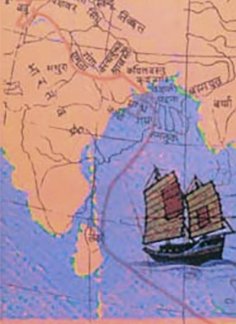
The history of Bharat traces the identification of countries, villages, towns and other regions of India, as well every bit imperial dynasties, rulers, tribes, local festivities and traditions and regional languages. Ancient India enjoyed religious liberty and encourages the path of Dharma, a concept common to Buddhism, Hinduism, and Jainism.
Marāthi-English language lexicon
Source: DDSA: The Molesworth Marāthi and English Dictionary
viṣṇu (विष्णु).—grand (Southward) 1 of the Hindu triad, Vishn̤u. He is considered as the Preserver. The several Avatars are emanations from his essence, except that of kṛṣṇa, in whom he is held to have been wholly incarnate. He is represented as a mild and chivalrous deity.
Source: DDSA: The Aryabhusan school lexicon, Marathi-English
viṣṇu (विष्णु).—k One of the Hindu triad.
Marathi is an Indo-European language having over 70 meg native speakers people in (predominantly) Maharashtra India. Marathi, similar many other Indo-Aryan languages, evolved from early forms of Prakrit, which itself is a subset of Sanskrit, one of the about aboriginal languages of the world.
Sanskrit dictionary
Source: DDSA: The practical Sanskrit-English language dictionary
Viṣṇu (विष्णु).—[viṣ vyāpane nuk Uṇ.three.39]
one) The second deity of the sacred Triad, entrusted with the preservation of the world, which duty he is represented to take duly discharged by his diverse incarnations; (for their descriptions see the several avatāras s. 5. and also under avatāra); the give-and-take is thus popularly derived :यस्माद्विश्व- मिदं सर्वं तस्य शक्त्या महात्मनः । तस्मादेवोच्यते विष्णुर्विशधातोः प्रवेशनात् (yasmādviśva- midaṃ sarvaṃ tasya śaktyā mahātmanaḥ | tasmādevocyate viṣṇurviśadhātoḥ praveśanāt) ||.
2) Name of Agni; विष्णुर्नामेह योऽग्निः (viṣṇurnāmeha yo'gniḥ) Mb.3.221.12.
iii) A pious man.
four) Proper name of a law-giver, author of a Smṛti chosen विष्णुस्मृति (viṣṇusmṛti).
5) Name of 1 of the Vasus.
6) The lunar mansion called Śravaṇa (presided over by Viṣṇu).
7) Name of the month चैत्र (caitra).
Derivable forms: viṣṇuḥ (विष्णुः).
Source: Cologne Digital Sanskrit Dictionaries: Edgerton Buddhist Hybrid Sanskrit Dictionary
Viṣṇu (विष्णु).—(ane) due north. (i.eastward. probably an chemical element in the chemical compound proper name) of a large group of kings: prabhanāmā sahasrāṇi viṣṇunāmā tathaiva ca (Ārya-)Mañjuśrīmūlakalpa 625.24 (poetry), thousands with names containing prabha, and also containing Viṣṇu; in 26 a single one of them, perhaps referred to as named Viṣṇu, merely: teṣām apaścimo rājā viṣṇunāmā bhavi- ṣyati; (ii) name of a yakṣa leader: Mahā-Māyūrī 235.31.
Source: Cologne Digital Sanskrit Dictionaries: Shabda-Sagara Sanskrit-English Dictionary
Viṣṇu (विष्णु).—g.
(-ṣṇuḥ) Vishnu, one of the three principal Hindu deities, and the preserver of the earth: during the periods of temporary annihilation, he is supposed to sleep on the waters floating on the serpent Sesha: Brahma is fabled to have sprung from a lotus, which originally grew from the belly button of Vishnu, and the holy river Ganges is said to jump from his foot: the different Avatars are considered as emanations of this deity, and in Krishna, he is supposed to have been really and wholly incarnate: Lakshmi is his wife, and he is commonly represented as a mild and chivalrous deity. 2. Agni or fire. 3. One of the demigods chosen Vasus. iv. A pure or pious man. five. The proper noun of an ancient police-giver. E. viś to enter or pervade, (the universe,) nuk Unadi aff.
Source: Cologne Digital Sanskrit Dictionaries: Benfey Sanskrit-English Lexicon
Viṣṇu (विष्णु).—i. e. 2. viṣ + nu, yard. 1. Viṣṇu, one of the iii principal Indian deities,
Source: Cologne Digital Sanskrit Dictionaries: Cappeller Sanskrit-English Dictionary
Viṣṇu (विष्णु).—[masculine] [Name] of a god; [abstruse] tva† [neuter]
Source: Cologne Digital Sanskrit Dictionaries: Aufrecht Catalogus Catalogorum
i) Viṣṇu (विष्णु) as mentioned in Aufrecht's Catalogus Catalogorum:—pupil of the astronomer Gopīrāja. Mentioned in Mārtaṇḍavallabhā.
2) Viṣṇu (विष्णु):—father of Dhanaṃjaya (Daśarūpaka). Oxf. 203^a.
3) Viṣṇu (विष्णु):—father of Dhanika (Daśarūpakaṭīkā). Oxf. 203^a.
4) Viṣṇu (विष्णु):—male parent of Rāmeśvara (Rasarājalakṣmī). Oxf. 321^a.
5) Viṣṇu (विष्णु):—son of Hīrabhaṭṭa, grandson of Kṛṣṇa, father of Koṇeribhaṭṭa, grandpa of Rudra Bhaṭṭa (Vaidyajīvanaṭīkā). Oxf. 318^a.
vi) Viṣṇu (विष्णु):—of the Daśaputra family unit, begetter of Gadādhara, grandfather of Sadāśiva (Liṅgārcanacandrikā). L. 1944.
vii) Viṣṇu (विष्णु):—Mentioned in Āśvalāyanagṛhyakārikā 1, 31.
8) Viṣṇu (विष्णु):—Āśvalāyanaprayogavṛtti. He follows Devasvāmin, Nārāyaṇa, and others.
ix) Viṣṇu (विष्णु):—Kālyaṣṭaka.
10) Viṣṇu (विष्णु):—Kuṇḍamarīcimālā.
11) Viṣṇu (विष्णु):—Vidhyaparādhaprāyaścitta.
12) Viṣṇu (विष्णु):—Śivamahimnaḥstotra.
xiii) Viṣṇu (विष्णु):—Gaṇapāṭha.
14) Viṣṇu (विष्णु):—son of Muktinātha (Mūrtinātha): Anargharāghavaṭīkā.
Source: Cologne Digital Sanskrit Dictionaries: Monier-Williams Sanskrit-English Lexicon
1) Viṣṇu (विष्णु):—m. ([probably] [from] √viṣ, 'All-pervader' or 'Worker') Proper noun of one of the principal Hindū deities (in the afterward mythology regarded as 'the preserver', and with Brahmā 'the creator' and Śiva 'the destroyer', constituting the well-known Tri-mūrti or triad; although Viṣṇu comes second in the triad he is identified with the supreme deity by his worshippers; in the Vedic period, however, he is not placed in the foremost rank, although he is frequently invoked with other gods [especially] with Indra whom he assists in killing Vṛtra and with whom he drinks the Soma juice; cf. his later names Indrānuja and Upendra; equally distinguished from the other Vedic deities, he is a personification of the light and of the sun, [especially] in his striding over the heavens, which he is said to practice in three paces [See tri-vikrama and cf. bali, vāmana], explained as denoting the threefold manifestations of light in the form of fire, lightning, and the sun, or equally designating the three daily stations of the sun in his rise, culminating, and setting ; Viṣṇu does not appear to have been included at get-go amid the Ādityas q.5., although in later times he is accorded the foremost identify among them; in the Brāhmaṇas he is identified with cede, and in i described as a dwarf; in the Mahā-bhārata and Rāmāyaṇa he rises to the supremacy which in some places he now enjoys equally the well-nigh popular deity of modern Hindū worship; the great rivalry betwixt him and Śiva cf. vaiṣṇava and śaiva is not fully developed till the period of the Purāṇas: the distinguishing feature in the character of the Post-vedic Viṣṇu is his condescending to become incarnate in a portion of his essence on ten principal occasions, to evangelize mankind from sure great dangers cf. avatāra and, [Indian Wisdom, by Sir M. Monier-Williams 327]; some of the Purāṇas make 22 incarnations, or even 24, instead of 10; the Vaiṣṇavas regard Viṣṇu as the supreme being, and often identify him with Nārāyaṇa, the personified Puruṣa or earliest living spirit [described as moving on the waters, reclining on Śeṣa, the serpent of infinity, while the god Brahmā emerges from a lotus growing from his navel; cf. [Manu i, 10]]; the wives of Viṣṇu are Aditi and Sinīvālī, later Lakṣmī or Śrī and even Sarasvatī; his son is Kāma-deva, god of dear, and his paradise is called Vaikuṇṭha; he is unremarkably represented with a peculiar mark on his breast chosen Śrī-vatsa, and as property a śaṅkha, or conch-shell called Pāñcajanya, a cakra or quoit-like missile-weapon chosen Su-darśana, a gadā or club called Kaumodakī and a padma or lotus; he has also a bow called Śārṅga, and a sword chosen Nandaka; his vāhana or vehicle is Garuḍa q.v.; he has a jewel on his wrist called Syamantaka, another on his breast called Kaustubha, and the river Ganges is said to issue from his foot; the demons slain by him in his character of 'preserver from evil', or by Kṛṣṇa equally identified with him, are Madhu, Dhenuka, Cāṇūra, Yamala, and Arjuna [see yamalārjuna], Kāla-nemi, Haya-grīva, Śakaṭa, Ariṣṭa, Kaiṭabha, Kaṃsa, Keśin, Mura, Śālva, Mainda, Dvi-vida, Rāhu, Hiraṇya-kaśipu, Bāṇa, Kāliya, Naraka, Bali; he is worshipped under a chiliad names, which are all enumerated in [Mahābhārata xiii, 6950-7056]; he is sometimes regarded as the divinity of the lunar mansion chosen Śravaṇa), [Ṛg-veda] etc. etc. (cf. [Religious Thought and Life in India 44; Indian Wisdom, by Sir M. Monier-Williams 324])
2) Proper name of the month Caitra, [Varāha-mihira's Bṛhat-saṃhitā]
3) (with prājāpatya) of the author of [Ṛg-veda x, 84]
4) of a son of Manu Sāvarṇa and Bhautya, [Mārkaṇḍeya-purāṇa]
5) of the author of a law-volume, [Yājñavalkya]
6) of the male parent of the 11th Arhat of the present Avasarpiṇī, [cf. Lexicographers, esp. such as amarasiṃha, halāyudha, hemacandra, etc.]
7) (also with gaṇaka, kavi, daivajña, paṇḍita, bhaṭṭa, miśra, yatīndra, vājapeyin, śāstrin etc.) of diverse authors and others, [Inscriptions; Catalogue(s)]
viii) = agni, [cf. Lexicographers, esp. such equally amarasiṃha, halāyudha, hemacandra, etc.]
ix) = vasu-devatā, [cf. Lexicographers, esp. such every bit amarasiṃha, halāyudha, hemacandra, etc.]
ten) = śuddha, [cf. Lexicographers, esp. such as amarasiṃha, halāyudha, hemacandra, etc.]
11) f. Proper noun of the mother of the 11th Arhat of the present Avasarpiṇī, [cf. Lexicographers, esp. such as amarasiṃha, halāyudha, hemacandra, etc.]
12) north. [plural] (in a formula), [Āpastamba-śrauta-sūtra]
xiii) (viṣṇor with apamarṇam, ājya-doham, vratam; [oḥ] sāma, svarīyaḥ Name of Sāmans; with ṣoḍaśa-nāma-stotram, anusmṛtiḥ, aṣṭāviṃśati-nāma-stotram, and mahā-stutiḥ Name of works.)
Source: Cologne Digital Sanskrit Dictionaries: Yates Sanskrit-English language Dictionary
Viṣṇu (विष्णु):—(ṣṇuḥ) 2. m. Vishnu the preserver; fire; good homo.
Source: DDSA: Paia-sadda-mahannavo; a comprehensive Prakrit Hindi lexicon (S)
Viṣṇu (विष्णु) in the Sanskrit language is related to the Prakrit words: Viṇhu, Vinhu.
[Sanskrit to German]
Vishnu in German language
Sanskrit, likewise spelled संस्कृतम् (saṃskṛtam), is an aboriginal linguistic communication of India commonly seen every bit the grandmother of the Indo-European linguistic communication family (fifty-fifty English language!). Closely centrolineal with Prakrit and Pali, Sanskrit is more exhaustive in both grammar and terms and has the about extensive collection of literature in the world, greatly surpassing its sister-languages Greek and Latin.
Hindi lexicon
Source: DDSA: A practical Hindi-English language dictionary
Viṣṇu (विष्णु):—(nm) ane of the Hindu mythological divine trinity- [brahmā,viṣṇu] and [maheśa] the preserver of the world, God Almighty; ~[patnī] goddess [lakṣmī]—the spouse of [viṣṇu].
...
Kannada-English dictionary
Source: Alar: Kannada-English corpus
Viṣṇu (ವಿಷ್ಣು):—
1) [noun] one of the most prominent deities of HIndus; the preserver of the world order.
2) [noun] proper name of one of the twelve Adityas, a course of gods.
3) [noun] an esoteric hymn, of which Viṣṇu is the presiding deity.
4) [noun] the brightest star in the constellation Aquila; Altair.
5) [noun] Agni, the Burn down-God.
6) [noun] (pros.) a gear up of three syllables (some times the initial long ane is substituted by two short ones making it five) which can be put in eight combinations.
Kannada is a Dravidian language (as opposed to the Indo-European linguistic communication family unit) mainly spoken in the southwestern region of India.
Starts with (+330): Vishnu agnihotrin, Vishnu bhatta, Vishnu daivajna, Vishnu ganaka, Vishnu kavi, Vishnu mishra, Vishnu Mudra, Vishnu pandita, Vishnu sarvajna, Vishnu shastrin, Vishnu vajapeyin, Vishnu yatindra, Vishnu-bahu, Vishnu-griha, Vishnu-muhurta, Vishnu-shradha, Vishnubali, Vishnubha, Vishnubhadra, Vishnubhadri.
Ends with (+38): Adhyambhavishnu, Agnavishnu, Alambhavishnu, Amavishnu, Anadhyambhavishnu, Andhambhavishnu, Anuvishnu, Apamambhavishnu, Apavishnu, Aprabhavishnu, Asubhagambhavishnu, Ativishnu, Bhavishnu, Bhutavishnu, Brihadvishnu, Devavishnu, Dhanyavishnu, Dhritivishnu, Dirgha-vishnu, Durambhavishnu.
Full-text (+9064): Varaha, Vaikuntha, Vaishnava, Kesava, Vamana, Lakshmi, Shrivatsa, Narayana, Kalki, Narasimha, Janardana, Prativishnu, Upendra, Vishnupada, Garuda, Dashavatara, Brahma, Vishnu Purana, Ritadhaman, Asuraripu.
Search found 205 books and stories containing Vishnu, Viṣṇu, Visnu; (plurals include: Vishnus, Viṣṇus, Visnus). You lot can also click to the full overview containing English textual excerpts. Below are direct links for the most relevant manufactures:
Click here for all 205 books
Source: https://www.wisdomlib.org/definition/vishnu
0 Response to "Vishnu Dreaming the Universe Art Sculpture Who Made It"
Post a Comment